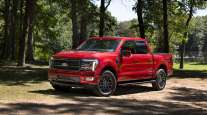Ford Announces Reshuffling, New Self-Driving Vehicle Unit

A day ahead of announcing second-quarter earnings, Ford Motor Co. unveiled organizational changes that it says will improve its operations and grow profits.
It also created a new unit to help speed its development and commercialization of self-driving cars.
The new unit, Ford Autonomous Vehicles, will be based in Detroit’s Corktown and include Ford’s self-driving systems integration, autonomous vehicle research and advanced engineering, AV transportation-as-a-service network development, user experience, business strategy and business development teams.
RELATED: Volvo unit UD Trucks eyes autonomous vehicles to ease driver shortage in Japan
The moves are part of Ford’s reorganization of its global operations leadership, the automaker said, to drive stronger product development, grow profits and reduce costs.
“We’re looking at every part of our business, making it more fit and ensuring that every action we take is driven by what will serve our customers in a way that supports our fitness and performance goals,” Ford CEO Jim Hackett said in a statement.
Company reorganization
Ford is reorganizing its global operations division run by Joe Hinrichs to improve manufacturing for faster vehicle delivery and reduced inventories at lower costs, according to the company. Global operations now will include information technology as well as a global order-to-delivery system. This should help Ford integrate the teams, technologies and processes from both areas across Ford’s production system, according to the manufacturer.
“We can now harness this technology to unlock a new world of vehicle personalization, supply chain choreography and inventory leanness that rivals any industrial model in the world — and Joe’s challenge is to help us redesign this system to do just that — while better serving customers and dealers and improving our overall fitness,” Hackett said.
Hau Thai-Tang, Ford’s executive vice president of product development and purchasing, now will report to Hackett. This will ensure that product development has “an even stronger voice” in Ford, the statement said.
RELATED: Minnesota safety officials look to driverless vehicles to reduce fatalities
Under Thai-Tang, Ford is moving to flexible vehicle architectures and more common parts across its models. That will shorten the time it takes to develop a car from sketch to the showroom by 20%, saving Ford nearly $7 billion in engineering costs, the automaker said. Ford’s goal is to have the most efficient product development among automakers within five years.
All the organizational changes are effective Aug. 1.
Additionally, Jim Farley, president of global markets, will lead an effort to design products based on customer insights. By 2020, Ford vows to have the freshest lineup in North America, with its average showroom age dropping to 3.3 years from 5.7 years. It has similarly aggressive plans in other regions, including Europe and Asia.
An investor move
Ford also is consolidating its autonomous driving platform into one team to help it commercialize self-driving cars.
Ford Autonomous Vehicles primarily will be based at Ford’s Corktown campus. It is structured to take on third-party investment, but Ford’s ownership stake will be held in Argo Al, the company’s Pittsburgh-based partner for self-driving system development, Ford said. Ford expects to invest $4 billion in its AV efforts through 2023, including its $1 billion investment in Argo AI.
Ford Autonomous Vehicles’ CEO will be Sherif Marakby, currently Ford vice president of autonomous vehicles and electrification. Marakby will report to a board of directors headed by Marcy Klevorn, Ford’s president of mobility, to closer align Ford’s self-driving platform with its mobility solutions team.
RELATED: Ford refuses to rush into robo-taxis, even after GM, Waymo deals
Analysts say FAV will help Ford leaders make AV decisions faster but will not result in bringing AVs to market sooner than any other company because there still is a lot of product development to be done across the board. The real benefit lies in how the financial markets perceive FAV adding value, said Sam Abuelsamid, senior analyst with Navigant Research in Detroit.
“If you look at what happened to General Motors after it announced its deal between its self-driving unit, GM Cruise, and SoftBank, this will have a similar outcome,” Abuelsamid said.
In May, GM announced it was partnering with technology investor SoftBank Vision Fund to invest in GM Cruise technology. SoftBank, a large technology investment company with stakes in such companies as Uber, will invest $2.25 billion in GM Cruise Holdings, and GM will invest $1.1 billion in GM Cruise.
GM stock closed that day at $42.70, up 12.87%.
“Even if this news doesn’t move Ford stock immediately, it provides the potential for them to bring in other partners to take a stake in it and offload some of the cost of developing this technology and getting it ready for deployment,” Abuelsamid said. “It also helps spread the risk if they have partners. It’s less of a hit on Ford’s bottom line.”
Awkward phase
This latest news comes a day before all three Detroit carmakers are due to report second-quarter earnings. And while most automakers grew sales in the quarter, analysts said, Ford’s sales declined by nearly 1%, indicating second-quarter results could be weak. A group of 18 analysts estimate Ford will report an earnings of 32 cents per share, according to MarketWatch.
For the first quarter, Ford earned 43 cents per share, beating Wall Street analysts’ average expectations by 2 cents per share. In the year-ago period, it reported earnings of 40 cents a share.
Ford is “in the midst of an awkward in-between phase where it needs to sell down passenger cars as it shifts its product mix to trucks and SUVs, and it’s having to lean heavily on incentives to do it,” said Jeremy Acevedo, manager of industry analysis for Edmunds.
Acevedo said Ford’s decision to back away from passenger cars is making times tough for it as it faces the additional challenge of popular SUVs such as Escape and Explorer getting “a little long in the tooth at a time when competition couldn’t be more stiff.”
Distributed by Tribune Content Agency, LLC




